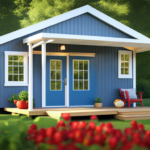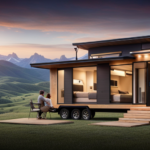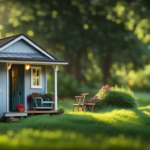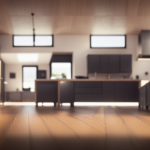Beginners Guides
How Much Does A 2 Bedroom Tiny House Cost
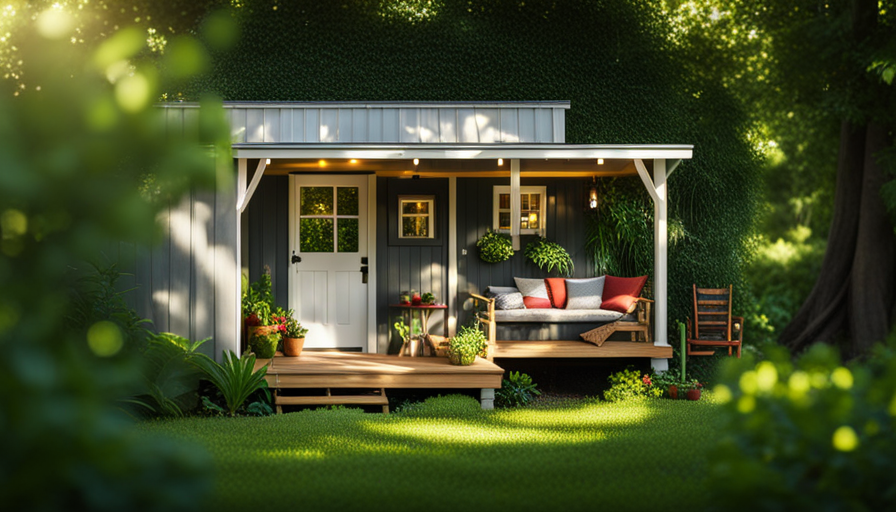
Envision entering a snug yet roomy 2-bedroom tiny home surrounded by the natural world. Sunlight pours in through the expansive windows, casting light on the thoughtfully arranged interior. Delving deeper, you discover ingenious storage options, contemporary conveniences, and an overarching sense of peace that fills the space.
But amidst the allure of minimalist living, a nagging question remains: how much does a 2 bedroom tiny house actually cost? In this article, I will delve into the various factors that affect the cost of these diminutive dwellings, ranging from the size and type of construction to the location and customizations. By examining real-life examples, analyzing financing options, and offering cost-saving tips, I aim to provide a comprehensive understanding of the investment required.
So, whether you’re considering downsizing or seeking an alternative lifestyle, join me as we unravel the intricacies of the 2 bedroom tiny house market.
Key Takeaways
- Factors affecting the cost of a 2 bedroom tiny house include size, layout, materials, customization, and location.
- The average cost of a 2 bedroom tiny house ranges from $40,000 to $150,000, including materials and labor.
- Tips to save costs include opting for simpler designs, affordable materials, DIY options, and alternative building methods.
- Financing options for a 2 bedroom tiny house include rent-to-own programs, specialized tiny home loans, and personal loans.
Types of 2 Bedroom Tiny Houses
If you’re looking for a cozy haven that’ll make your heart skip a beat, check out the various types of 2-bedroom tiny houses available.
These small and compact dwellings offer a unique living experience while providing all the essential amenities.
When it comes to cost comparison, there are several factors to consider.
The first is the size and layout of the tiny house. Different designs may offer varying square footage, with some models featuring loft bedrooms or additional storage spaces.
Additionally, the materials used in construction can greatly impact the overall cost. Some tiny houses are built with high-quality, sustainable materials, while others may utilize more cost-effective options.
Furthermore, the level of customization and design options can also affect the price. If you prefer a more basic, standard design, the cost may be lower compared to a fully customized tiny house with unique features and finishes.
Considering these factors, it’s clear that the cost of a 2-bedroom tiny house can vary greatly depending on your preferences and choices.
Moving forward, let’s explore the factors affecting the cost in more detail.
Factors Affecting the Cost
When considering the price of a two-bedroom tiny house, various factors come into play that can significantly impact the overall investment you’ll make. Here are four factors that can affect the cost:
-
Location: The location of your tiny house can greatly influence the cost. Areas with high demand or desirable amenities will generally have higher prices.
-
Size and Design: The size and design of your tiny house will play a significant role in its cost. Custom designs and additional features will increase the price.
-
Materials and Construction: The choice of materials and construction methods can impact the cost. High-quality, eco-friendly materials will often result in a higher price tag.
-
Labor and Professional Services: The cost of hiring labor and professional services, such as architects or contractors, will also add to the overall cost.
To save on costs, consider these tips: opt for a simpler design, choose affordable materials without compromising quality, explore DIY options, and consider alternative building methods like prefab or modular construction.
These factors and cost-saving tips should be considered when planning your two-bedroom tiny house. Transitioning into the subsequent section about the average cost range, it’s important to note that understanding these factors is crucial in estimating the overall investment required.
Average Cost Range
Get ready to be amazed by the average price range of a two-bedroom tiny home, where the investment can skyrocket as high as reaching for the stars. When considering the cost of a 2-bedroom tiny house, it’s important to keep in mind that there are various factors that can affect the final price.
On average, the cost of a 2-bedroom tiny house can range from $40,000 to $150,000. This estimation includes both the cost of materials and labor.
To better understand the cost breakdown, it’s important to consider the different elements that contribute to the final price. These elements may include the size of the house, the quality of materials used, the complexity of the design, and the location of the build. Additionally, factors such as the need for customizations, off-grid capabilities, and energy-efficient features can also affect the overall cost.
As we transition into the subsequent section about financing options, it’s important to understand that the average cost estimation provides a general idea of the price range for a 2-bedroom tiny house. Financing options can help make this investment more accessible to individuals looking to own their own tiny home.
Financing Options
One way to make owning your dream two-bedroom tiny home more attainable is by exploring the various financing options available. Here are three options to consider:
-
Rent-to-Own: Some tiny home builders offer rent-to-own programs, allowing you to rent the tiny house for a specific period before eventually owning it. This option can be beneficial if you don’t have the immediate funds for a down payment or if you want to test out living in a tiny home before committing to ownership.
-
Traditional Mortgage: While tiny homes may not fit the criteria for a conventional mortgage, some lenders offer specialized tiny home loans. These loans typically require a larger down payment and may have higher interest rates, but they provide a more traditional financing option for those who prefer it.
-
Personal Loan: Another financing option is to take out a personal loan to cover the cost of your two-bedroom tiny home. Personal loans generally have higher interest rates than mortgages but can be a viable option if you have a good credit score and sufficient income.
By exploring these financing options, you can find a solution that best fits your financial situation and helps you realize your dream of owning a two-bedroom tiny home. As we move on to the next section about cost-saving tips and strategies, it’s important to consider these financing options alongside other ways to make your tiny home more affordable.
Cost-saving Tips and Strategies
When it comes to saving costs on building a tiny house, there are two key factors to consider: DIY vs. hiring professionals and recycling and repurposing materials.
Building a tiny house yourself can save you a significant amount of money, but it requires a certain level of skill and expertise. On the other hand, hiring professionals ensures a higher level of quality but can be more expensive.
Additionally, recycling and repurposing materials can significantly reduce the cost of construction by utilizing existing resources and minimizing waste.
DIY vs. Hiring Professionals
If you’re looking to save money, consider taking on the DIY approach when building your 2 bedroom tiny house – it can save you up to 20% of the overall cost compared to hiring professionals. DIY offers several benefits, including the ability to have complete control over the project and the satisfaction of building something with your own hands. Additionally, by doing the work yourself, you can customize the tiny house to your exact specifications, ensuring it meets your needs and preferences. However, it’s important to acknowledge the advantages of hiring professionals. They bring expertise and experience to the table, ensuring that the project is completed efficiently and to a high standard. They also have access to specialized tools and materials that may be necessary for certain aspects of the construction. Transitioning into the subsequent section about recycling and repurposing materials, it’s worth considering how these practices can further reduce costs and environmental impact.
Recycling and Repurposing Materials
By recycling and repurposing materials, you can not only save money but also contribute to a more sustainable and eco-friendly construction process for your 2-bedroom tiny home. Upcycling furniture is a great way to give new life to old pieces while adding character to your tiny home. Look for secondhand stores, garage sales, or even your own attic for unique finds that can be transformed into functional and stylish pieces for your interior.
Another option to consider is repurposing shipping containers. These sturdy structures can be converted into living spaces, providing an affordable and durable foundation for your tiny home. With a little creativity and some basic construction skills, you can transform these containers into cozy and efficient living spaces. Repurposing materials not only adds a unique touch to your tiny home but also reduces waste and environmental impact.
Transitioning into the next section, it’s important to consider the ongoing maintenance and expenses that come with owning a 2-bedroom tiny house.
Maintenance and Ongoing Expenses
To keep your 2-bedroom tiny house in great condition, you’ll want to budget for regular maintenance and ongoing expenses like utilities and insurance. Did you know that according to a study, the average annual cost of maintaining a tiny house is around $500? This includes routine tasks such as cleaning, painting, and repairing any wear and tear. Additionally, it’s important to factor in monthly expenses like water, electricity, and internet. These costs can vary depending on the location and usage, but on average, they amount to around $100 per month. To help you visualize the expenses, here is a table illustrating the estimated monthly costs for a 2-bedroom tiny house:
| Expense | Monthly Cost |
|---|---|
| Water | $30 |
| Electricity | $50 |
| Internet | $20 |
| Insurance | $50 |
| Maintenance | $42 |
| Total | $192 |
By budgeting for these maintenance costs and monthly expenses, you can ensure that your 2-bedroom tiny house stays in optimal condition. This will not only enhance your living experience but also contribute to its resale value and investment potential.
Resale Value and Investment Potential
Considering the potential for increased resale value and investment opportunities, you’ll be delighted to discover the long-term benefits of owning a 2-bedroom tiny house. One of the advantages of investing in a tiny house is its resale value, which has been steadily increasing over the years.
As the demand for sustainable and affordable housing options continues to rise, the resale value of tiny houses has shown promising growth. This is especially true for well-maintained and aesthetically appealing 2-bedroom tiny houses.
Additionally, owning a 2-bedroom tiny house opens up the possibility of generating rental income. Many individuals are seeking alternative accommodation options, and tiny houses are becoming increasingly popular for short-term rentals or as vacation homes. By renting out your 2-bedroom tiny house, you can potentially earn a steady stream of income, making it a profitable investment.
However, it is important to consider the potential risks and challenges associated with owning a tiny house. While the resale value and rental income potential are attractive, there are factors that can affect these benefits, such as location, market demand, and overall maintenance costs.
Understanding these pros and cons will help you make an informed decision about whether living in a 2-bedroom tiny house is the right fit for you.
Pros and Cons of Living in a 2 Bedroom Tiny House
Living in a 2-bedroom tiny house presents the opportunity for a simplified lifestyle and embracing minimalism. With limited space, it becomes necessary to prioritize and declutter, resulting in a more intentional way of living.
However, one must also consider the potential drawbacks, such as space limitations and privacy concerns. The compact size of a 2-bedroom tiny house may require creative storage solutions and careful consideration of personal boundaries to ensure a comfortable living environment.
Simplified Lifestyle and Minimalism
Imagine living in a 2-bedroom tiny house and experiencing a simplified lifestyle that’ll leave you wondering why you ever needed anything more. The minimalist interior design of a tiny house encourages a clutter-free environment, promoting a sense of calm and order. Downsizing to a smaller space has numerous benefits, such as reduced financial burden, lower maintenance costs, and increased environmental sustainability.
Additionally, the limited space forces you to prioritize your possessions, allowing you to focus on what truly matters. The simplicity of a tiny house allows for easier cleaning and organization, saving you time and stress. However, it’s important to acknowledge that living in a small space does come with its limitations and privacy concerns.
Transitioning into the next section, while tiny house living offers a simplified lifestyle, it’s essential to consider the challenges that arise from space limitations and privacy concerns.
Space Limitations and Privacy Concerns
After discussing the benefits of simplified lifestyle and minimalism in the previous section, it is important to address the space limitations and privacy concerns that come with living in a tiny house.
One of the biggest challenges of living in a small space is optimizing the available space for various activities. However, with careful planning and creative storage solutions, it is possible to make the most out of every square inch. From multifunctional furniture to utilizing vertical space, there are numerous strategies to maximize storage and ensure a clutter-free living environment.
Despite the limited space, privacy can still be achieved through thoughtful design choices such as room dividers, curtains, or even utilizing loft spaces as private retreats. By prioritizing space optimization and creative storage solutions, the challenges of living in a tiny house can be effectively managed.
Now let’s explore real-life examples and case studies to gain a deeper understanding of the cost associated with two-bedroom tiny houses.
Real-life Examples and Case Studies
In my research on the topic of real-life examples and case studies of tiny house owners, I’ve come across several success stories that highlight the benefits and joys of living in a tiny house.
These individuals have found creative ways to maximize space, reduce their expenses, and live a more sustainable lifestyle. However, it’s important to acknowledge that there are also challenges and lessons learned along the way.
Some of these challenges include dealing with zoning regulations, finding suitable storage options, and the need for careful planning and organization.
Overall, these real-life examples and case studies provide valuable insights into the world of tiny house living.
Success Stories of Tiny House Owners
You’ll love hearing about the success stories of tiny house owners and being inspired by their journeys. These stories highlight the benefits and drawbacks of living in a tiny house, providing valuable insights for those considering this lifestyle.
One success story features Sarah, who built her own tiny house and now enjoys financial freedom and the ability to travel extensively. Another success story is Mark, who downsized to a tiny house and found a sense of peace and simplicity in his life. These stories demonstrate the potential for a fulfilling and sustainable lifestyle in a tiny house.
However, they also highlight the challenges and lessons learned along the way. From zoning regulations to limited storage space, tiny house owners have faced obstacles that require creativity and adaptability. Despite these challenges, the success stories of tiny house owners show that the rewards outweigh the difficulties.
Challenges and Lessons Learned
Imagine navigating the maze of zoning regulations and finding creative solutions to limited storage space in order to create your dream small space oasis. Building and living in a tiny house comes with its fair share of challenges.
One of the biggest challenges I faced was dealing with zoning regulations. Many areas have strict rules and regulations regarding tiny houses, making it difficult to find a suitable place to park and live in them.
Another challenge was the limited storage space. Living in a tiny house means downsizing and getting rid of unnecessary belongings, but it also requires finding innovative ways to maximize storage.
Lastly, I learned the importance of proper insulation and ventilation. Maintaining a comfortable temperature and preventing moisture build-up can be a challenge in such a small space.
Overall, building and living in a tiny house has taught me valuable lessons about creativity, minimalism, and problem-solving.
Frequently Asked Questions
Are there any zoning restrictions or regulations to consider when building or placing a 2 bedroom tiny house?
Zoning restrictions and building regulations vary by location, so it’s important to research local laws before constructing or placing a 2 bedroom tiny house. Compliance with setback requirements, size limitations, and permit processes may be necessary.
How much does it cost to transport a 2 bedroom tiny house to a different location?
Transporting a 2 bedroom tiny house to a different location can be costly. Hiring professional movers can range from $3,000 to $8,000, depending on distance and complexity. DIY options, such as towing, may be cheaper but require specialized equipment and knowledge.
Can I customize the design and layout of a 2 bedroom tiny house to fit my specific needs?
Yes, customization options and design flexibility are available for 2 bedroom tiny houses. You can tailor the layout and design to fit your specific needs and preferences, ensuring a personalized and functional living space.
Are there any additional expenses to consider when living in a 2 bedroom tiny house, such as utilities or parking fees?
There are additional expenses to consider when living in a 2 bedroom tiny house, such as utilities expenses and potential parking fees. These costs can vary depending on location, size of the house, and individual usage.
What are the legal requirements and permits needed to build a 2 bedroom tiny house?
Building a 2 bedroom tiny house requires adhering to legal requirements and obtaining building permits. The process involves ensuring compliance with zoning regulations, obtaining permits for electrical and plumbing work, and meeting safety standards.
Conclusion
In conclusion, after analyzing the various factors affecting the cost of a 2-bedroom tiny house, it’s clear that the price can vary significantly. However, one thing is certain: the investment is worth it.
With the potential for cost-saving tips and strategies, as well as the increasing popularity of tiny houses, the resale value and investment potential are extraordinary.
Living in a 2-bedroom tiny house may require some adjustments, but the benefits far outweigh any drawbacks. Ultimately, the chance to live in a unique and affordable home is an opportunity that shouldn’t be missed.
Hi, I’m Emma. I’m the Editor in Chief of Tiny House 43, a blog all about tiny houses. While tree houses are often associated with childhood, they can be the perfect adult retreat. They offer a cozy space to relax and unwind, surrounded by nature. And since they’re typically built on stilts or raised platforms, they offer stunning views that traditional homes simply can’t match. If you’re looking for a unique and romantic getaway, a tree house tiny house might just be the perfect option.
Beginners Guides
How Do I Know Tiny House Is for Me

If you have ever had the dream of living in a tiny house, you are not alone. Before fully committing to minimalism, it is crucial to ask yourself: is a tiny house truly the right fit for me?
Let me tell you, it’s not just about a cute, little home on wheels. It’s a lifestyle that requires careful consideration and self-reflection.
In this article, I’ll guide you through the process of determining whether a tiny house is truly your perfect match.
Key Takeaways
- Maximize storage and utilize clever storage solutions to make the most out of limited space
- Evaluate lifestyle and priorities to determine if minimalism, sustainability, and financial flexibility align with personal values
- Consider the financial implications of living in a tiny house, including adjusting spending habits and exploring loan options
- Embrace the benefits of minimalism, such as reduced stress, increased productivity, financial freedom, and environmental sustainability
Assessing Your Space Needs
Assessing my space needs, I’ll consider my lifestyle and the activities I enjoy. When it comes to living in a tiny house, maximizing storage and making use of multi-functional furniture is key. With limited space, it’s important to be strategic in how I organize and store my belongings. By utilizing clever storage solutions such as under-bed storage, built-in shelves, and hanging organizers, I can make the most out of every inch of space.

Additionally, investing in multi-functional furniture, like a sofa that can double as a guest bed or a coffee table with hidden storage compartments, allows for versatility and efficiency in a tiny house. By incorporating these strategies, I can ensure that I’ve enough space to live comfortably and enjoy the activities I love.
Now, let’s move on to evaluating your lifestyle and priorities.
Evaluating Your Lifestyle and Priorities
When considering if a tiny house is right for me, I need to take into account my lifestyle and what I prioritize. Evaluating personal values and determining space requirements are crucial steps in making this decision. Here are some key factors to consider:
-
Simplifying my life: Tiny houses promote minimalism and can help me declutter and focus on what truly matters.
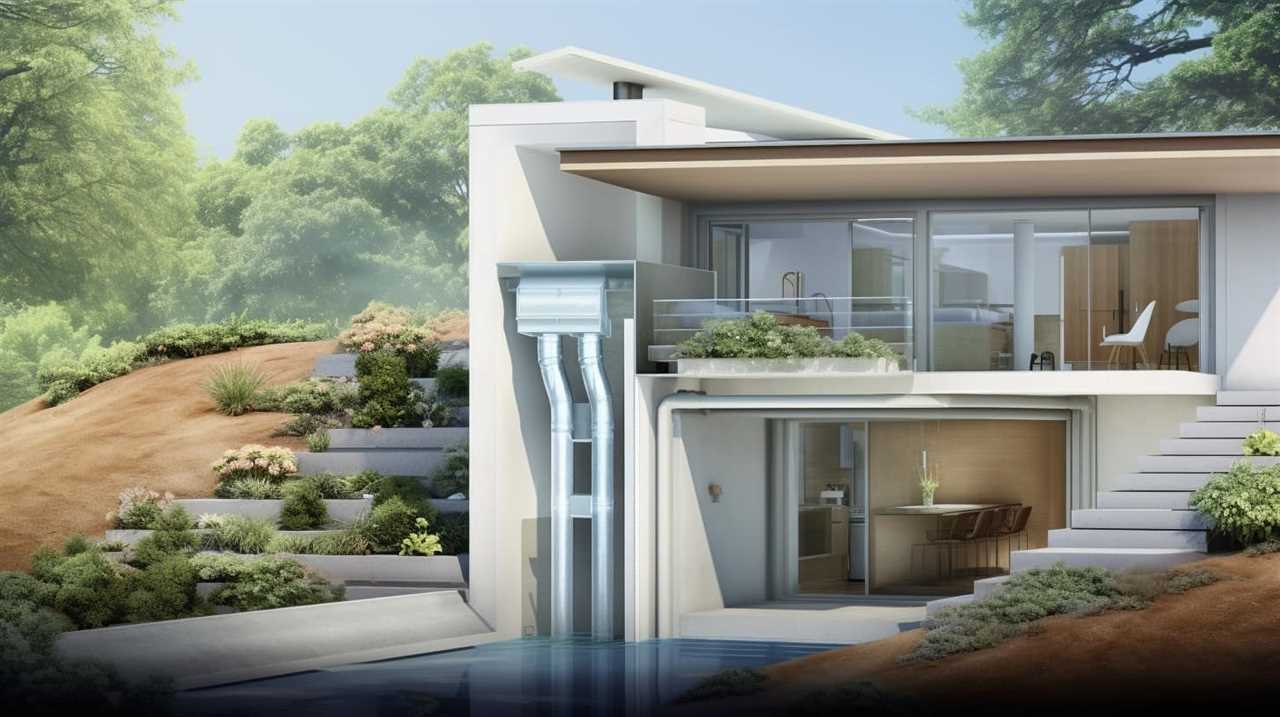
-
Environmental impact: Living in a tiny house allows me to reduce my carbon footprint and live a more sustainable lifestyle.
-
Financial freedom: Downsizing to a tiny house can significantly lower my expenses and provide me with more financial flexibility.
-
Mobility and flexibility: Tiny houses are portable, allowing me to easily relocate or travel without being tied down to a specific location.
Considering the Financial Implications
I should also consider the financial implications of living in a tiny house. While the cost of a tiny house itself may be significantly lower than a traditional home, there are other factors to consider. For instance, you may need to make adjustments to your lifestyle and spending habits to accommodate the smaller space. Additionally, it is important to explore loan options if you require financing for your tiny house. Some lenders offer specialized loans for tiny house purchases, while others may consider it a personal loan. It is crucial to carefully review the terms and interest rates before making a decision. Moreover, considering the long-term sustainability of your financial situation is essential to ensure that you can maintain your tiny house lifestyle in the future. By being mindful of your financial situation, you can create a sustainable and fulfilling life in a tiny home.
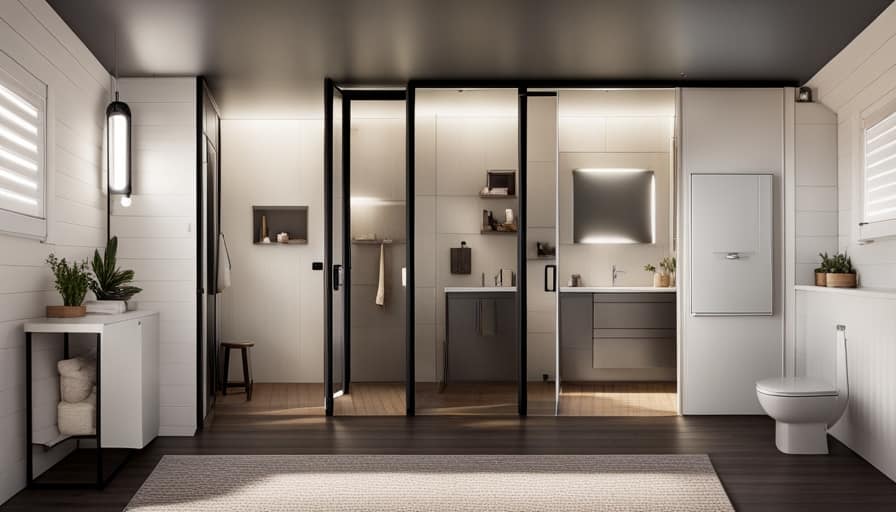
| Financial Implications |
|---|
| Adjusting lifestyle and spending habits |
| Exploring loan options |
| Considering long-term sustainability |
Now that we have explored the financial implications of living in a tiny house, let’s move on to the next section and explore the benefits of minimalism.
Exploring the Benefits of Minimalism
One of the key advantages of minimalism is that it allows me to simplify my life and focus on what truly matters. Embracing decluttering and exploring simplicity can have a profound impact on our overall well-being.
Here are some benefits of incorporating minimalism into our lives:
-
Reduced stress: By decluttering our physical spaces and letting go of unnecessary possessions, we create a calming environment that promotes relaxation and peace of mind.
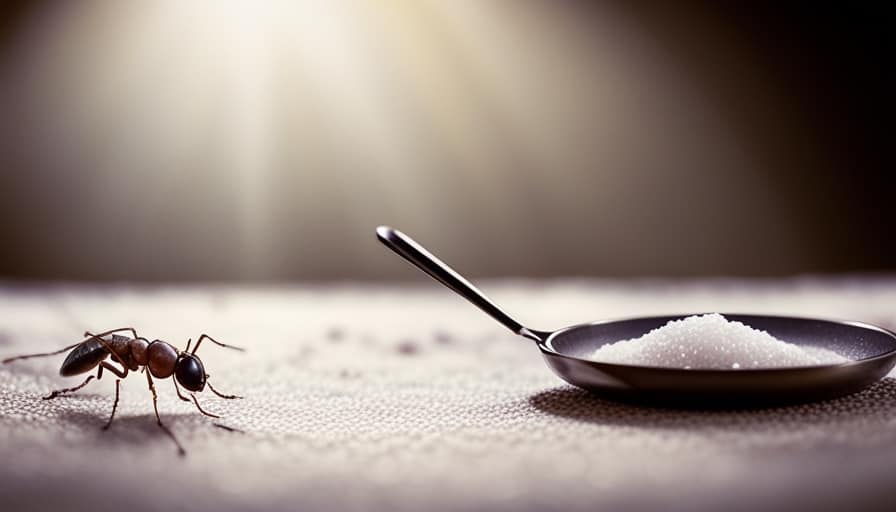
-
Increased productivity: When we eliminate distractions and simplify our surroundings, we can better focus our energy and attention on the tasks that truly matter, leading to increased productivity.
-
Financial freedom: Minimalism encourages us to evaluate our spending habits and prioritize our needs over wants. This can lead to reduced expenses and financial freedom.
-
Environmental sustainability: By adopting a minimalist lifestyle, we consume less and reduce our carbon footprint, contributing to a more sustainable planet.
Understanding the Challenges of Tiny Living
Despite the limited space, living in a tiny house offers unique opportunities for organization and creativity.
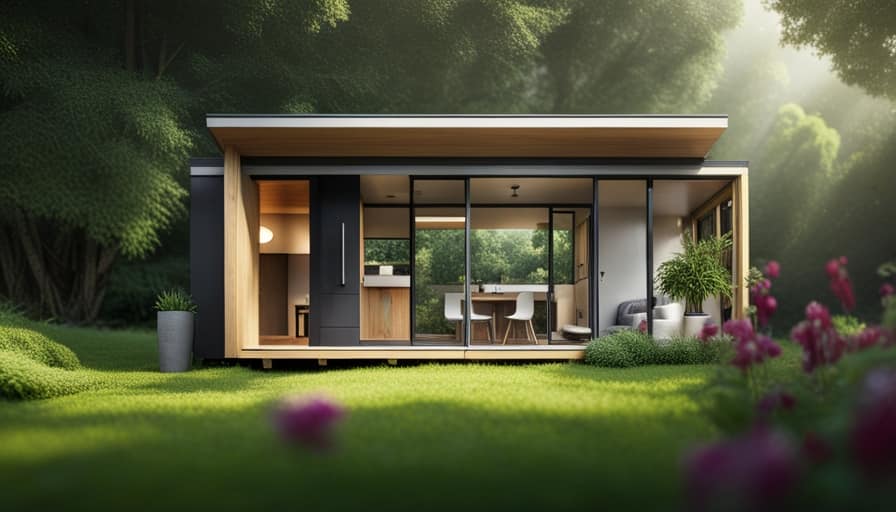
One of the main challenges of tiny living is space optimization. It requires careful planning and creative solutions to make the most of every square inch. However, this challenge can be seen as an opportunity to simplify and declutter our lives. By carefully curating our belongings, we can prioritize what truly matters to us and let go of unnecessary items.
Maintaining personal belongings can be a challenge in a tiny house, but it can also be a chance to develop a more intentional mindset. We learn to value quality over quantity and to appreciate the things that truly bring us joy.
With a little creativity and a willingness to let go, the challenges of tiny living can become opportunities for personal growth and a more meaningful life.
Frequently Asked Questions
How Can I Find Land to Park My Tiny House On?
Finding suitable parking for a tiny house can be challenging. It’s important to research local zoning laws and regulations, reach out to landowners, and explore alternative options like tiny house communities or renting land from homeowners.
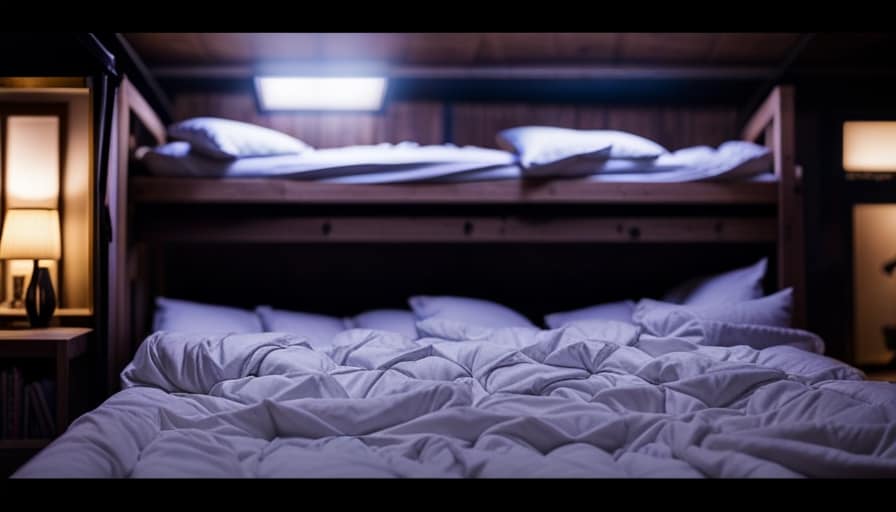
Are There Any Legal Restrictions or Regulations I Should Be Aware of When Living in a Tiny House?
There are legal restrictions and zoning regulations to consider when living in a tiny house. It’s important to research and understand these rules to ensure you can legally and comfortably live in your tiny home.
What Are the Options for Heating and Cooling a Tiny House?
Heating options for a tiny house include electric heaters, wood-burning stoves, and propane heaters. Cooling options may include window air conditioners, portable air conditioners, or ceiling fans. Consider your climate and personal preferences when choosing.
Can I Have Pets in a Tiny House?
Having pets in a tiny house can be a challenge, but it’s not impossible. Zoning restrictions and limited space should be considered, but with proper planning and creativity, you can create a cozy and pet-friendly environment.
How Do I Handle Waste Management, Such as Sewage and Garbage Disposal, in a Tiny House?
Handling waste management in a tiny house involves implementing waste reduction strategies and utilizing composting toilets. These practices promote sustainability and minimize environmental impact. By responsibly managing sewage and garbage disposal, we can create a greener and more efficient living space.
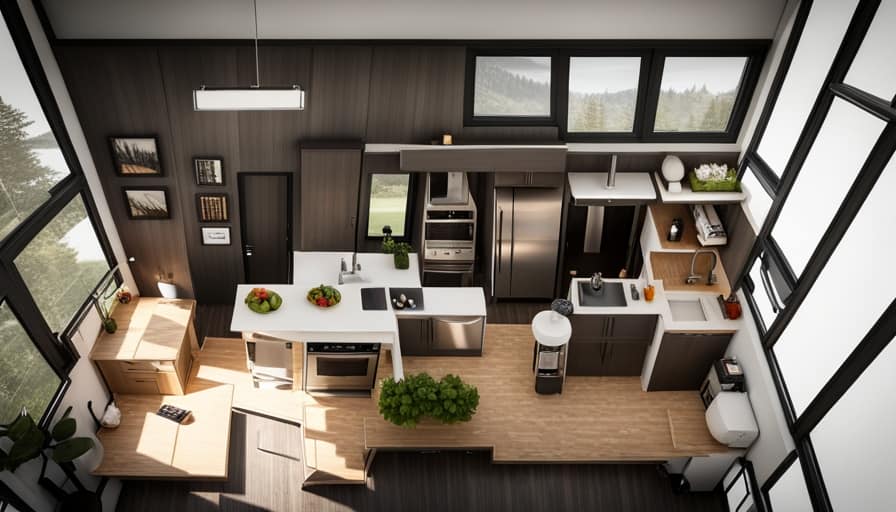
Conclusion
After considering the factors and doing thorough research, I’ve come to the conclusion that a tiny house is indeed the perfect fit for me.
Assessing my space needs, evaluating my lifestyle, and understanding the financial implications have all pointed towards the benefits of minimalism and the challenges of tiny living.
It’s amazing how coincidentally this decision aligns with my desire for simplicity and the need to prioritize what truly matters in life.
Ultimately, a tiny house offers the opportunity for a more fulfilling and sustainable way of living.
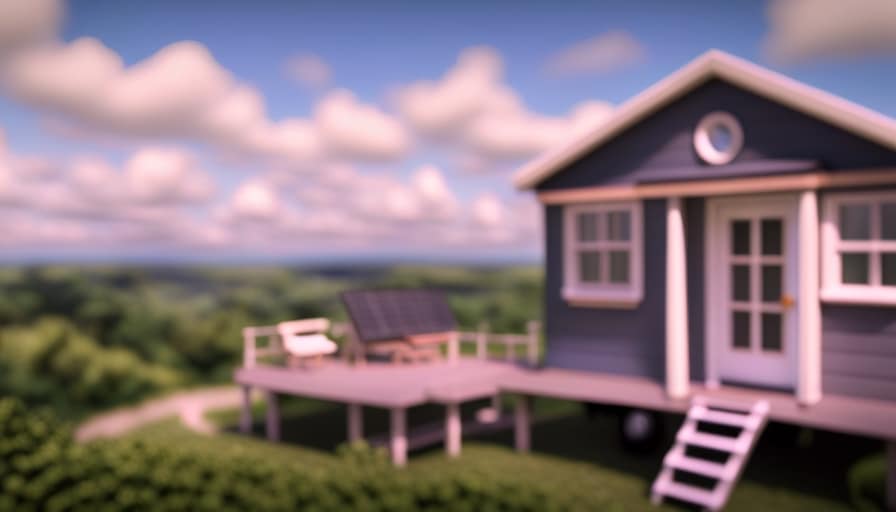
I’m Theodore, and I love tiny houses. In fact, I’m the author of Tiny House 43, a book about tiny houses that are also tree houses. I think they’re magical places where imaginations can run wild and adventures are just waiting to happen.
While tree houses are often associated with childhood, they can be the perfect adult retreat. They offer a cozy space to relax and unwind, surrounded by nature. And since they’re typically built on stilts or raised platforms, they offer stunning views that traditional homes simply can’t match.
If you’re looking for a unique and romantic getaway, a tree house tiny house might just be the perfect option.
Beginners Guides
How Cheap Can a Tiny House Shellon Wheels Cost
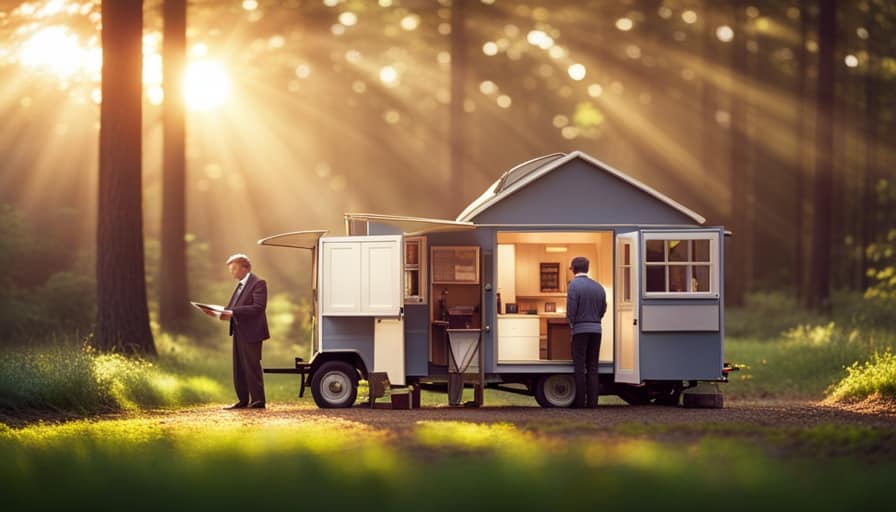
I have exciting news for all the budget-friendly tiny house fans out there! Brace yourself, as we are about to explore the realm of extremely affordable tiny house shells on wheels.
You won’t believe how cheap these gems can be. I’ve done my research, and I’m here to spill all the details on finding the best bargains, DIY methods, and cost-saving tips for customizing your dream home.
So, buckle up and prepare to embark on a journey towards affordable tiny house living!
Key Takeaways
- Affordable options for tiny house shells include using budget-friendly materials like reclaimed wood, recycled metal, and alternative building materials.
- DIY methods for building a budget-friendly tiny house shell include using reclaimed or salvaged materials, incorporating creative space-saving solutions, and repurposing items for storage.
- Bargains for cheap tiny house shells on wheels can be found by searching online marketplaces, attending local auctions, researching and comparing prices, and negotiating the price.
- Cost-saving tips for customizing a tiny house shell include utilizing multipurpose furniture, taking on DIY projects, maximizing storage with shelves and hooks, and looking for cost-saving hacks like repurposed furniture and DIY decor.
Researching Affordable Tiny House Shell Options
I’ll start by exploring different manufacturers that offer affordable tiny house shell options. When it comes to constructing a tiny house shell on a budget, it’s essential to consider using budget-friendly materials. Many manufacturers understand the need for cost-effective solutions and offer options that cater to this market. These include using materials like reclaimed wood, recycled metal, and alternative building materials. By using these budget-friendly materials, you can significantly reduce the overall cost of your tiny house shell build.

In addition to using budget-friendly materials, there are creative ways to save money on a tiny house shell build. One option is to purchase a pre-built tiny house shell from a manufacturer. This allows you to take advantage of their bulk purchasing power and expertise to get a high-quality shell at a lower cost. Another option is to explore DIY kits that come with pre-cut materials and instructions, allowing you to save money by doing the construction yourself.
Transitioning into the next section, let’s now explore DIY methods for building a budget-friendly tiny house shell.
Exploring DIY Methods for Building a Budget-Friendly Tiny House Shell
Let’s delve into various DIY techniques to construct a budget-friendly tiny house shell.
When it comes to building a tiny house on a budget, exploring alternative materials is key. Instead of traditional lumber, consider using reclaimed or salvaged materials to save money and reduce waste.

Additionally, creative space-saving solutions can make a big difference in maximizing the functionality of your tiny house. Utilize multifunctional furniture, like a sofa that converts into a bed or a foldable dining table.
Think outside the box and repurpose items for storage, such as using old suitcases as shelves or installing hooks on walls for hanging pots and pans.
Finding Bargains: Where to Look for Cheap Tiny House Shells on Wheels
Scouring online marketplaces and attending local auctions can be effective strategies for finding cheap tiny house shells on wheels. When searching for affordable options, it’s important to know where to look and how to negotiate the price. Here are some tips to help you in your search:
- Best websites for finding affordable tiny house shells on wheels:
| Website | Description |
|---|---|
| Tiny House Listings | A popular online marketplace for tiny houses |
| Craigslist | Local classifieds often have listings for shells |
| eBay | Auction-style platform with various options |
- Tips for negotiating the price of a cheap tiny house shell on wheels:
- Do your research and compare prices to know the market value.
- Be prepared to negotiate and offer a lower price.
- Highlight any repairs or modifications needed as leverage for a lower price.
- Consider purchasing in the off-season when prices might be lower.
Cost-Saving Tips for Customizing Your Tiny House Shell
When customizing my tiny house shell, I often look for cost-saving tips to stay within my budget. Here are some customization ideas and space-saving solutions that can help you save money while still creating a functional and beautiful tiny home:
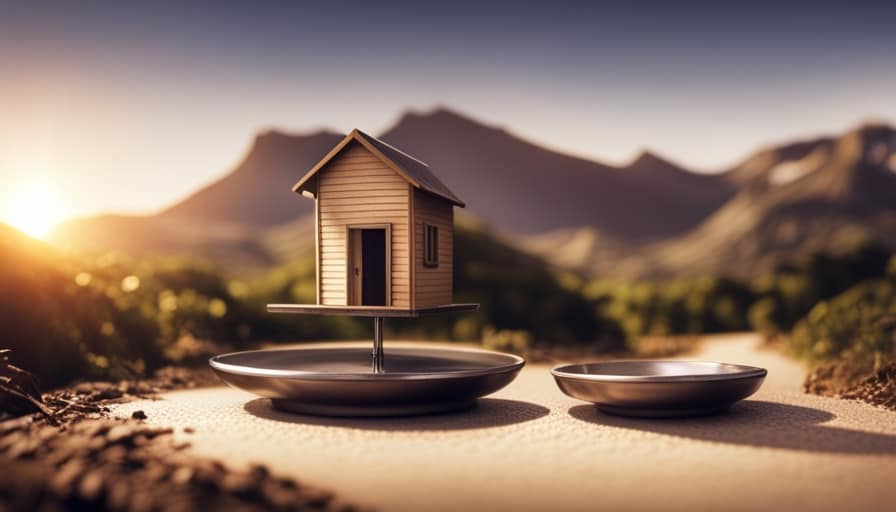
-
Utilize multipurpose furniture: Look for furniture pieces that can serve multiple functions, such as a sofa that can be transformed into a bed or a table with built-in storage.
-
DIY projects: Instead of buying expensive custom-built furniture or storage solutions, consider taking on some do-it-yourself projects. You can repurpose old materials or find affordable options at thrift stores or online marketplaces.
-
Optimize vertical space: Maximize storage by utilizing vertical space. Install shelves, hooks, and hanging organizers to make the most of every inch. You can also consider using wall-mounted folding tables or Murphy beds to save space.
Comparing Prices: How Much Can You Save With a Tiny House Shell on Wheels?
I saved a significant amount of money by comparing prices and opting for a tiny house shell on wheels rather than a traditional home. When I started exploring financing options for my tiny house, I was amazed at how much more affordable it was compared to a conventional house. Not only did I save on the initial cost of construction, but I also avoided the expenses associated with buying land and paying property taxes. Additionally, the mobility of a tiny house shell on wheels offers several benefits. I can easily move my home to different locations, allowing me to explore new areas and experience different communities. It also gives me the flexibility to live closer to work or family if needed. Overall, choosing a tiny house shell on wheels has not only saved me money, but it has also provided me with a sense of freedom and adventure.
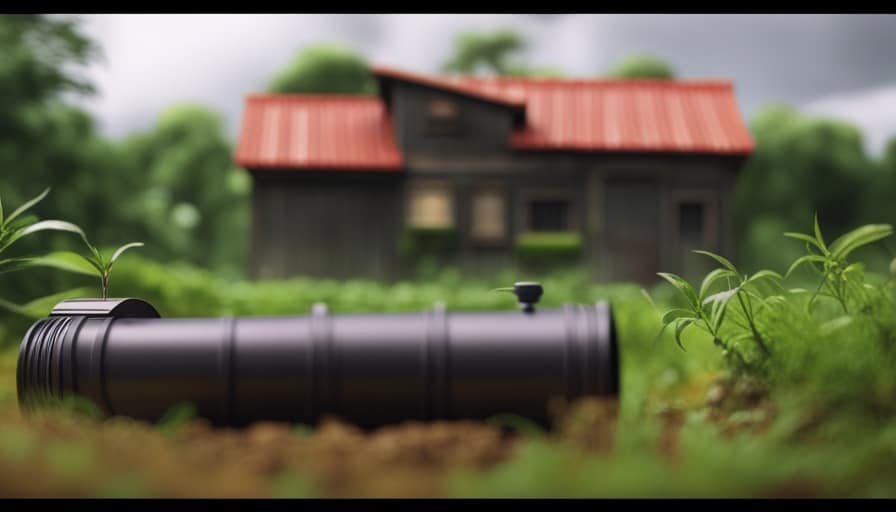
| Benefits of a Mobile Tiny House | Cost Savings |
|---|---|
| Mobility and flexibility | Lower construction cost |
| Opportunity to explore new areas | No property taxes |
| Ability to live closer to work or family | No land purchase expenses |
Frequently Asked Questions
What Are the Common Challenges Faced When Researching Affordable Tiny House Shell Options?
When researching affordable tiny house shell options, one of the common challenges is finding reliable information. It requires thorough research to ensure the options are truly affordable and meet one’s specific needs.
Are There Any Specific Materials or Techniques That Can Help in Building a Budget-Friendly Tiny House Shell?
Budget-friendly materials and construction techniques are essential when building a tiny house shell. By using cost-effective materials and efficient construction methods, it is possible to create a budget-friendly tiny house on wheels.
Where Can I Find Reliable Sources for Cheap Tiny House Shells on Wheels?
Finding affordable tiny house shells on wheels can be a challenge, but with some expert bargain hunting, it is possible to find reliable sources. It’s important to research extensively and compare prices to ensure you get the best deal.
What Are Some Cost-Saving Tips or Hacks for Customizing a Tiny House Shell?
When it comes to customizing a tiny house shell, there are several cost-saving tips and hacks to consider. From using budget-friendly materials to DIY projects, these strategies can help keep your expenses low while still creating a personalized and comfortable space.
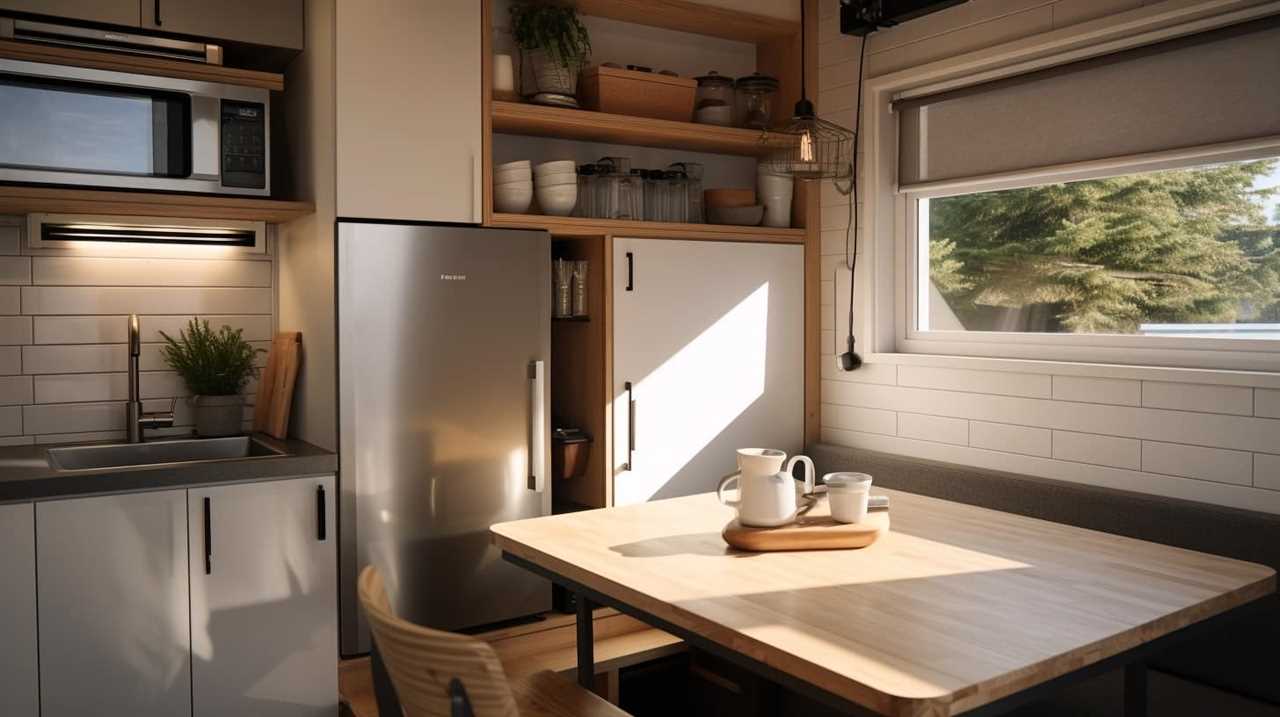
How Does the Price of a Tiny House Shell on Wheels Compare to Other Housing Options in Terms of Long-Term Savings?
In terms of long-term savings, a tiny house shell on wheels can offer significant financial benefits. Compared to other housing options, it allows for lower utility costs and fewer maintenance expenses, making it a cost-effective choice.
Conclusion
After researching affordable options and exploring DIY methods, it’s clear that a tiny house shell on wheels can be an incredibly cost-effective choice.
By finding bargains and utilizing cost-saving tips, individuals can customize their tiny house shell to fit their needs and save even more money.
Comparing prices will reveal just how much can be saved with this practical and budget-friendly housing solution.

So why wait? Take the leap into the world of tiny house living and start saving today.
I’m Theodore, and I love tiny houses. In fact, I’m the author of Tiny House 43, a book about tiny houses that are also tree houses. I think they’re magical places where imaginations can run wild and adventures are just waiting to happen.
While tree houses are often associated with childhood, they can be the perfect adult retreat. They offer a cozy space to relax and unwind, surrounded by nature. And since they’re typically built on stilts or raised platforms, they offer stunning views that traditional homes simply can’t match.
If you’re looking for a unique and romantic getaway, a tree house tiny house might just be the perfect option.
Beginners Guides
How Can You Save Money While Living in a Tiny House on Wheels

As someone who lives in a tiny house on wheels, I’ve discovered that downsizing does not equate to compromising financial stability. On the contrary, it can actually lead to improved financial security!
By embracing a minimalist lifestyle and making smart choices, I’ve discovered countless ways to save money. From efficient energy use to creative storage solutions, this article will show you how to keep more cash in your pocket while enjoying the freedom and simplicity of tiny house living.
Let’s dive in and uncover the secrets to financial freedom on the move!
Key Takeaways
- Incorporate smart home technology to efficiently use energy and reduce utility costs.
- Minimize maintenance costs by regularly inspecting and maintaining all systems and components.
- Utilize creative storage solutions to maximize space and reduce the need for additional storage.
- Grow your own food to save money and enjoy the benefits of fresh, homegrown produce.
Efficient Energy Use
I can save money by using efficient energy in my tiny house on wheels.
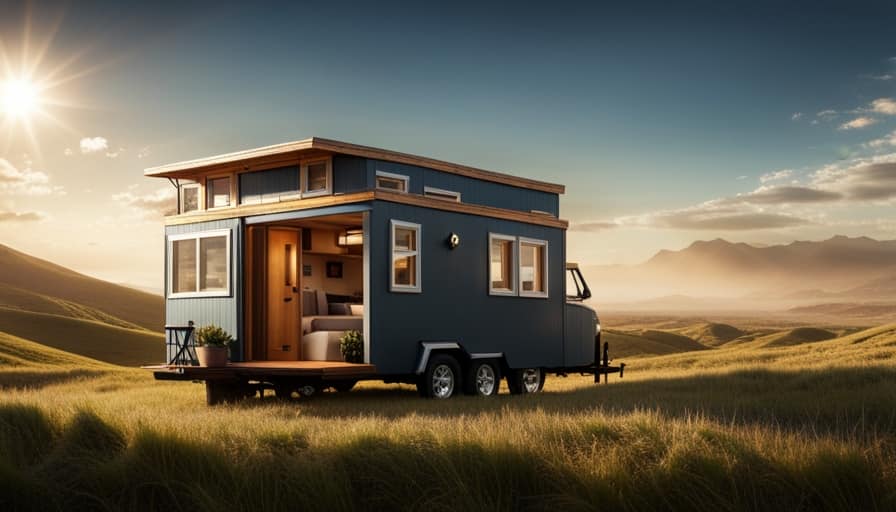
One way to achieve this is by incorporating smart home technology into my energy systems. Smart home technology allows me to monitor and control the energy consumption of my appliances and devices remotely. By using smart plugs, smart thermostats, and smart lighting systems, I can ensure that energy is only used when needed, reducing wastage and ultimately saving money.
Another way to save money is by utilizing renewable energy sources. Installing solar panels on the roof of my tiny house allows me to harness the power of the sun to generate electricity. Not only is this environmentally friendly, but it also reduces my reliance on the grid and lowers my energy bills. Additionally, using wind turbines or micro-hydro systems can further supplement my energy needs.
Minimizing Maintenance Costs
To minimize maintenance costs while living in a tiny house on wheels, it’s important to regularly inspect and maintain all systems and components. By taking a proactive approach, you can reduce the need for costly repairs and optimize the resources available to you. Here are some practical tips to help you minimize maintenance costs:
| Maintenance Tips | Benefits |
|---|---|
| Regularly check for leaks and water damage | Prevents costly repairs due to water damage |
| Clean and lubricate moving parts | Extends the lifespan of mechanical components |
| Keep the exterior clean and well-maintained | Prevents rust and deterioration |
| Inspect and maintain electrical systems | Reduces the risk of electrical issues and potential hazards |
Creative Storage Solutions
Maximizing storage space is crucial when living in a tiny house on wheels. In order to make the most of the limited space available, it’s important to utilize creative storage solutions.

One way to achieve this is by incorporating hidden compartments into your furniture. For example, you can have a bed with built-in storage underneath or a coffee table that opens up to reveal additional space. This allows you to keep your belongings neatly tucked away, while still having easy access to them.
Another option is to invest in multi-functional furniture. This means choosing pieces that serve more than one purpose. For instance, a sofa that can also be used as a bed or a dining table that can be folded away when not in use.
Growing Your Own Food
One way to save money while living in a tiny house on wheels is by growing your own food and incorporating it into your meals. Vertical gardening and hydroponic systems are excellent options for maximizing space and growing a variety of fruits, vegetables, and herbs.
Vertical gardening involves growing plants vertically, using walls or structures to support them. This allows you to make the most of limited space and grow a larger quantity of produce.
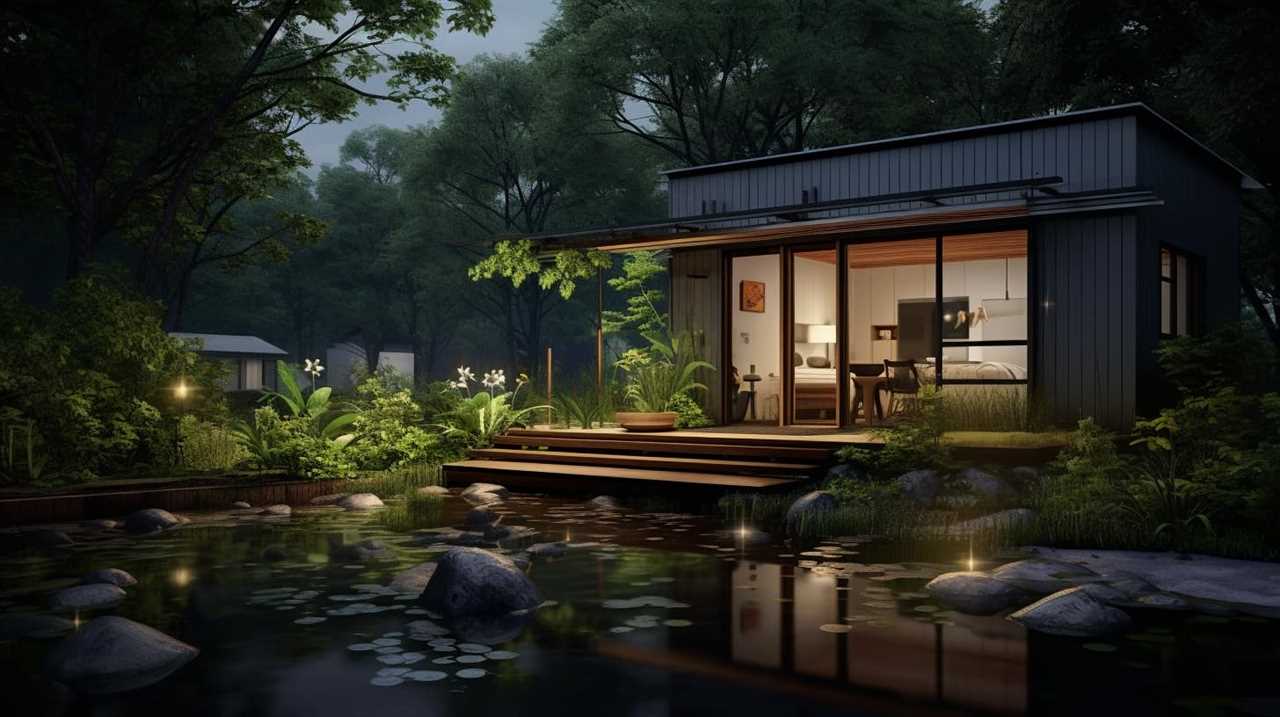
Hydroponic systems, on the other hand, allow you to grow plants without soil, using nutrient-rich water instead. This method is highly efficient and can produce higher yields compared to traditional gardening.
By growing your own food, you not only save money but also have the satisfaction of knowing exactly where your food comes from.
Transitioning into embracing a minimalist lifestyle, let’s explore how to downsize your possessions and simplify your living space.
Embracing a Minimalist Lifestyle
I love the freedom that comes with embracing a minimalist lifestyle in my tiny house on wheels. Living in a small space has forced me to reassess my belongings and prioritize what’s truly important.
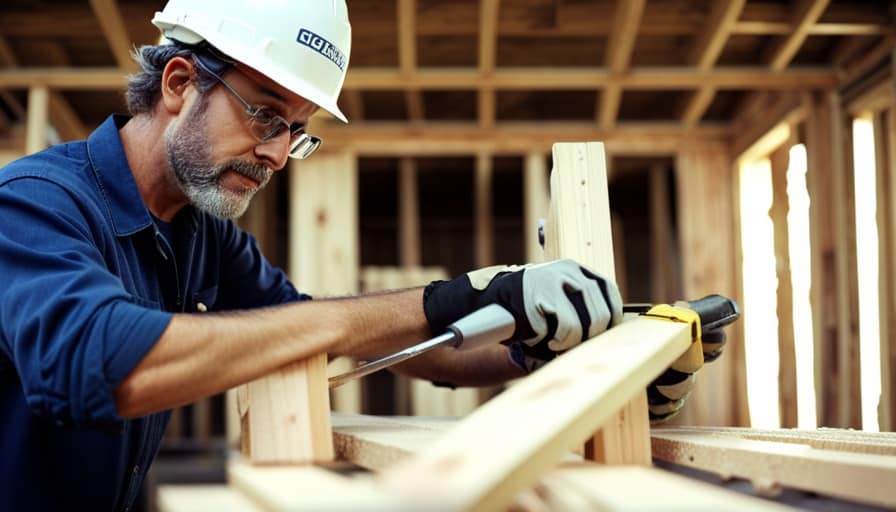
Here are three ways that embracing a minimalist lifestyle in a tiny house on wheels can lead to sustainable living and reduce your environmental impact:
-
Decluttering: By getting rid of excess possessions, you’re reducing waste and promoting a more mindful consumption. This leads to a simpler and more sustainable way of living.
-
Energy Efficiency: With limited space, you become more conscious of your energy consumption. Installing energy-efficient appliances and using natural light can significantly reduce your environmental footprint.
-
Eco-friendly Materials: Choosing sustainable and durable materials for your tiny house, such as reclaimed wood or recycled materials, not only reduces waste but also helps to preserve natural resources.
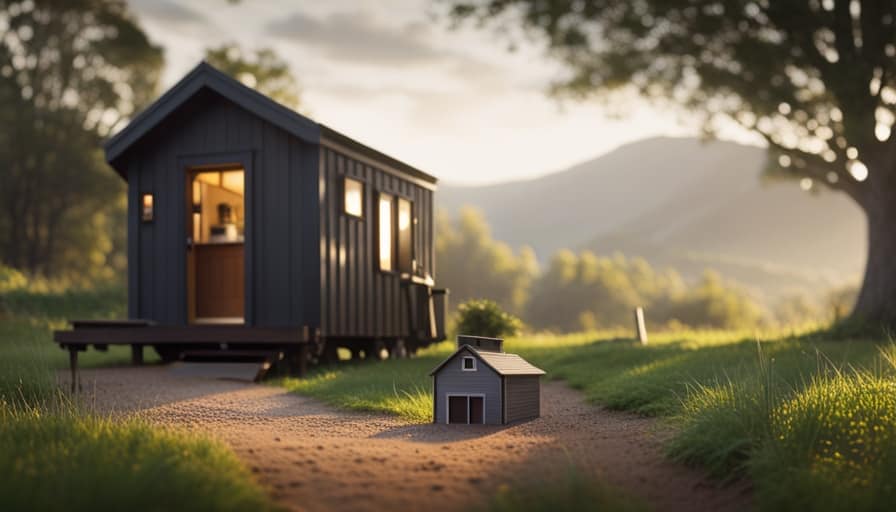
Embracing a minimalist lifestyle in a tiny house on wheels can’t only save you money but also contribute to a more sustainable and environmentally friendly way of living.
Frequently Asked Questions
How Can I Legally Live in a Tiny House on Wheels?
To legally live in a tiny house on wheels, you need to research and comply with local zoning laws and building codes. Ensure your tiny house meets all legal requirements and obtain necessary permits for parking and utilities.
What Are the Potential Challenges of Living in a Tiny House on Wheels?
Living in a tiny house on wheels presents potential challenges, such as limited space and mobility restrictions. However, with some tips and tricks, like minimizing possessions and conserving resources, it is possible to overcome these challenges and live comfortably.
Are There Any Specific Restrictions or Regulations for Parking a Tiny House on Wheels?
Parking restrictions and legal requirements for tiny houses on wheels vary depending on location. It’s important to research local zoning laws, building codes, and permit requirements to ensure compliance and avoid any potential fines or legal issues.
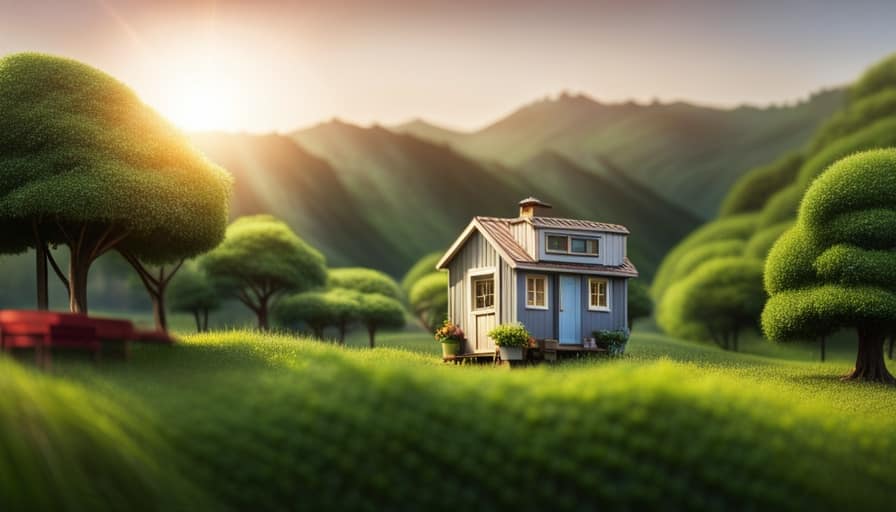
Can I Still Have a Comfortable and Functional Living Space in a Tiny House on Wheels?
Yes, it is possible to have a comfortable and functional living space in a tiny house on wheels. By maximizing storage, utilizing multipurpose furniture, and prioritizing organization, you can create a space that meets your needs.
How Can I Ensure the Safety and Security of My Tiny House on Wheels?
To ensure privacy and prevent theft in my tiny house on wheels, I can implement security measures like installing sturdy locks, using window coverings, and keeping valuable items out of sight.
Conclusion
Living in a tiny house on wheels can be a great way to save money. By focusing on efficient energy use, minimizing maintenance costs, creative storage solutions, and growing your own food, you can significantly reduce your expenses.
Embracing a minimalist lifestyle is also key to saving money in a tiny house. Did you know that the average cost to build a tiny house is only around $23,000, compared to the average cost of a traditional house, which is over $200,000?
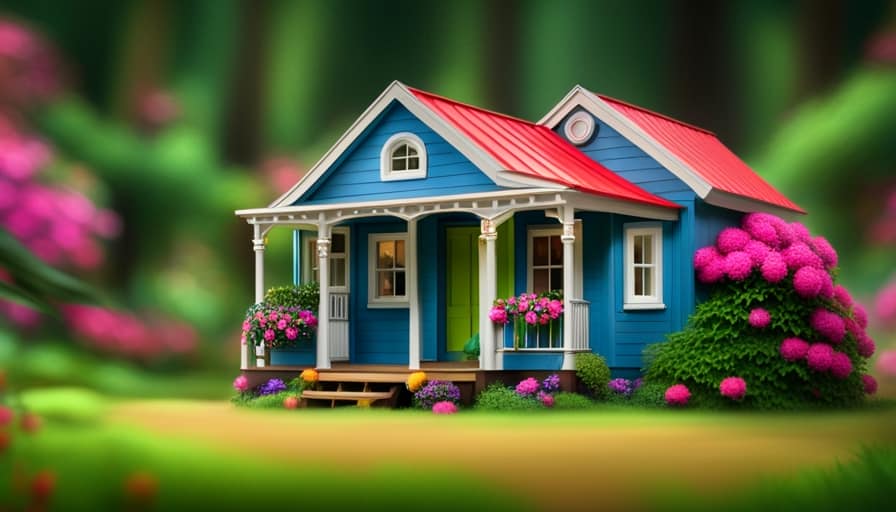
I’m Theodore, and I love tiny houses. In fact, I’m the author of Tiny House 43, a book about tiny houses that are also tree houses. I think they’re magical places where imaginations can run wild and adventures are just waiting to happen.
While tree houses are often associated with childhood, they can be the perfect adult retreat. They offer a cozy space to relax and unwind, surrounded by nature. And since they’re typically built on stilts or raised platforms, they offer stunning views that traditional homes simply can’t match.
If you’re looking for a unique and romantic getaway, a tree house tiny house might just be the perfect option.
-

 Beginners Guides2 weeks ago
Beginners Guides2 weeks agoHow To Buy A Tesla Tiny House
-

 Energy Efficiency1 month ago
Energy Efficiency1 month agoBest Tiny Homes For Cold Climates
-

 Beginners Guides7 days ago
Beginners Guides7 days agoTiny House Nation Where Are They Now Stephanie
-

 Tiny House Resources (e.g., legalities, cost, insurance, FAQs)2 months ago
Tiny House Resources (e.g., legalities, cost, insurance, FAQs)2 months agoDo Tiny Homes Need Planning Permission?
-

 Beginners Guides2 weeks ago
Beginners Guides2 weeks agoFrom The Show Tiny House Nation How Many Keep Their Tiny House?
-

 Beginners Guides2 months ago
Beginners Guides2 months agoUsing a Climbing Net For Treehouse Construction
-

 Beginners Guides2 months ago
Beginners Guides2 months agoHow to Build a Treehouse Without Drilling Into the Tree
-

 Beginners Guides3 weeks ago
Beginners Guides3 weeks agoTiny House Nation Who Pays For The Houses





